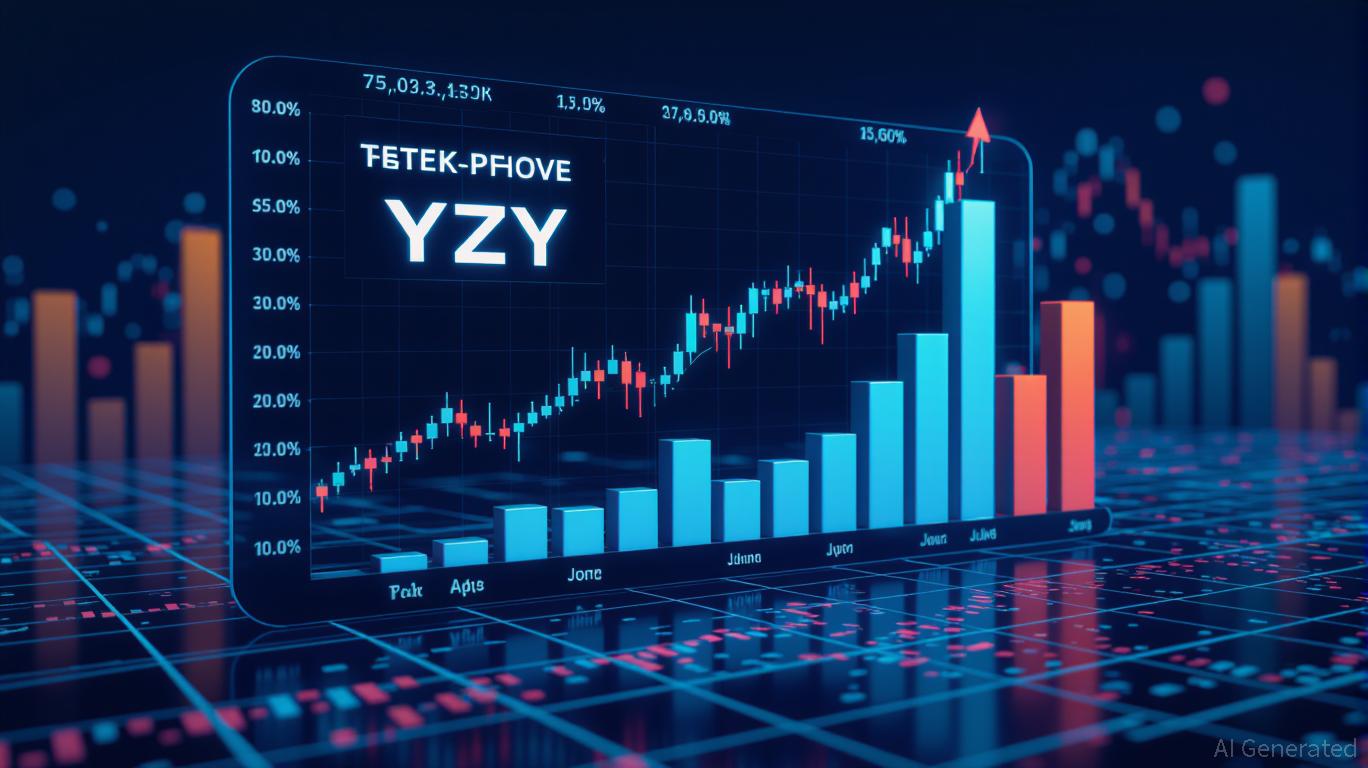The Semiconductor Renaissance: How SoftBank's $2 Billion Intel Bet Signals AI's Next Frontier
- SoftBank's $2B Intel investment signals confidence in AI-driven semiconductor demand, aligning with Intel's U.S. manufacturing and tech pivot. - U.S. government support via CHIPS Act and Trump-era equity stakes creates a $10.9B public-private partnership to bolster semiconductor independence. - Intel's stock rebound and strategic AI infrastructure bets highlight the sector's consolidation phase, urging investors to prioritize semiconductor leaders and AI infrastructure. - Risks include stiff competition
In the post-pandemic tech landscape, artificial intelligence has emerged not just as a buzzword but as the linchpin of global economic transformation. From cloud computing to autonomous systems, AI's insatiable demand for high-performance semiconductors has reshaped the industry. Against this backdrop, SoftBank Group's $2 billion investment in Intel Corporation—announced in August 2025—has sent shockwaves through the market. This move, which positions SoftBank as one of Intel's top shareholders, is more than a financial transaction; it is a strategic declaration of confidence in the future of AI-driven semiconductor demand and a harbinger of a new era in tech investing.
The Strategic Alignment: SoftBank and Intel's AI Synergy
SoftBank's investment in Intel is rooted in a shared vision of accelerating the AI revolution. For Intel, this infusion of capital comes at a critical juncture. After years of struggling to regain its footing in the AI chip market—where rivals like Nvidia have dominated—Intel is now doubling down on U.S.-based manufacturing and next-generation process technologies. The company's $100+ billion expansion plan, including a flagship Arizona fabrication site, is poised to deliver cutting-edge semiconductors tailored for AI workloads. SoftBank's stake, at $23 per share, not only validates Intel's strategic pivot but also aligns with the Japanese conglomerate's broader AI ambitions.
SoftBank, meanwhile, has long positioned itself as a global AI enabler. Its ownership of Arm Holdings and Ampere Computing, coupled with its leadership in the $500 billion “Stargate” data center initiative with OpenAI and Oracle , underscores its commitment to building the infrastructure for AI's next phase. By investing in Intel, SoftBank is securing a direct pipeline to the silicon that powers AI's exponential growth. This partnership is a masterstroke: Intel gains a financial lifeline and strategic ally, while SoftBank gains a seat at the table in the semiconductor revolution.
The Geopolitical and Market Implications
The investment also reflects a broader geopolitical shift. As the U.S. government prioritizes semiconductor independence through initiatives like the CHIPS Act, Intel's collaboration with both private and public entities has become a cornerstone of national strategy. The Trump administration's $8.9 billion equity stake in Intel, combined with SoftBank's $2 billion, creates a $10.9 billion public-private partnership—a rare alignment of capital and policy. This synergy is critical for countering global supply chain vulnerabilities and ensuring the U.S. remains a leader in AI and semiconductor manufacturing.
For investors, the implications are clear: the AI semiconductor sector is entering a phase of unprecedented consolidation and innovation. Intel's stock, which had plummeted 60% in 2024, has shown signs of recovery in early 2025, rising over 5% in after-hours trading following the SoftBank announcement. This rebound suggests that the market is beginning to price in Intel's renewed focus on AI and domestic manufacturing.
The Investment Thesis: Navigating the AI Semiconductor Boom
For investors, the SoftBank-Intel partnership offers a blueprint for strategic AI investing. Here's how to position your portfolio:
- Prioritize Semiconductor Leaders with AI-Centric Roadmaps: Companies like Intel, TSMC , and ASML are not just chipmakers—they are enablers of AI's next wave. Look for firms with clear R&D pipelines in AI-specific architectures (e.g., neuromorphic computing, quantum-ready chips).
- Leverage Government-Backed Initiatives: The U.S. and other nations are pouring billions into semiconductor manufacturing. Firms benefiting from CHIPS Act grants or equity stakes (like Intel) are likely to outperform peers.
- Diversify into AI Infrastructure Playbooks: Beyond semiconductors, consider investments in data centers, cloud providers, and AI software platforms. The “Stargate” initiative, for example, represents a $500 billion opportunity in AI infrastructure.
- Monitor Global Supply Chain Dynamics: As geopolitical tensions persist, companies with diversified manufacturing footprints (e.g., Intel's Arizona and Ireland sites) will be better positioned to mitigate risks.
Risks and Realities
No investment is without risk. SoftBank's stock dipped following the Intel announcement, reflecting concerns about its aggressive tech bets. Additionally, Intel faces stiff competition from Nvidia and AMD in the AI chip space. However, the company's renewed focus on U.S. manufacturing and its partnership with SoftBank provide a buffer against these challenges. Investors should also watch for regulatory hurdles in cross-border semiconductor deals and potential overvaluation in the AI sector.
Conclusion: A New Dawn for AI Investing
SoftBank's $2 billion investment in Intel is more than a financial milestone—it is a signal that the AI semiconductor race is entering its defining phase. For investors, this moment demands a recalibration of strategies to capitalize on the intersection of AI, geopolitics, and technological innovation. By aligning with companies that are shaping the future of silicon and AI infrastructure, investors can position themselves to thrive in a world where semiconductors are the new oil.
As the dust settles on this landmark deal, one thing is certain: the next decade of tech investing will be defined by those who recognize the semiconductor as the beating heart of AI's global revolution. The time to act is now.
Disclaimer: The content of this article solely reflects the author's opinion and does not represent the platform in any capacity. This article is not intended to serve as a reference for making investment decisions.
You may also like
The Systemic Risks of Overleveraged Stablecoins: Lessons from the YZY Token Collapse
- Kanye West's YZY token collapsed 80% in days after a $3B Solana-based surge, exposing DeFi risks from celebrity-driven speculative tokens. - Centralized token allocation (70% to West's team) and liquidity pool flaws enabled insider profits while retail investors faced 10%+ slippage. - 3x leverage on platforms like Hyperliquid amplified losses, with one trader losing $704K as leveraged positions triggered cascading instability. - SEC's reactive enforcement and fragmented global crypto regulations (vs. EU'

Altcoin Opportunities Amid Cardano’s Potential Decline
- Cardano (ADA) faces bearish pressure near $0.87, with technical indicators signaling potential decline to $0.60 amid delayed upgrades and regulatory uncertainty. - Altcoin market consolidation (70% in top 10 projects) highlights undervalued opportunities in high-utility coins like MAXI, HYPER, LINK, and POL. - Contrarian strategies favor projects with real-world partnerships (e.g., Chainlink’s JPMorgan adoption) and scalable infrastructure over speculative narratives. - Macroeconomic risks, including Fed

K33’s Bitcoin Strategy and Regulatory Readiness Position the Company as a High-Growth Play in the Evolving Crypto Market
- K33 AB aligns with EU MiCA regulations through CASP licensing and TFR compliance, securing institutional trust in a fragmented crypto market. - The firm's Bitcoin treasury strategy, funded by SEK 85M share issuance, targets 1,000 BTC to leverage institutional demand for reserve assets. - Q2 2025 revenue doubled despite 25% market decline, driven by Bitcoin-backed services and partnerships like Goobit's custody infrastructure. - MiCA-ready infrastructure enables scalable revenue streams, including Smart L

Infrastructure-Driven Web3 Adoption in Asia: Unlocking Metaverse and Blockchain Opportunities
- Asian governments drive Web3 growth via regulatory reforms, including South Korea’s RWA tokenization sandbox and Japan’s tax incentives for blockchain gaming. - Enterprises like Sony and Kakao integrate blockchain into gaming and super apps, while metaverse platforms expand decentralized identity and cross-industry use cases. - Institutional investors fuel market maturation, with South Korea’s Kimchi Premium and Thailand’s G-Tokens unlocking new capital flows for Web3 infrastructure. - Key investment opp
